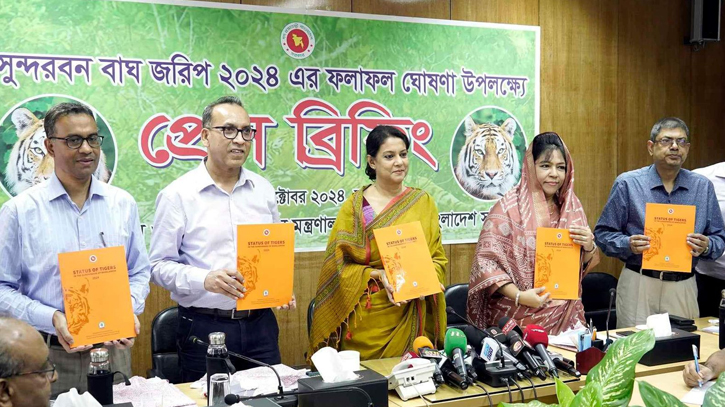
Photo : Collected
The tiger population in the Sundarbans, the world’s largest mangrove forest, has increased by 11 since the last survey, according to the latest ‘Sundarbans Tiger Survey 2024’. The results, announced today at a press conference at the Secretariat by Environment, Forest, and Climate Change Adviser Syeda Rizwana Hasan, show the tiger count rising from 114 in 2018 to 125 this year.
Adviser Rizwana attributed the growth to ongoing conservation efforts and stricter habitat protections. "The tiger population density in the Sundarbans is now 2.64 tigers per 100 square kilometers, a 9.65% increase since 2018 and a 17.92% rise from 2015," she said, citing data from the survey.
The survey utilized the camera trapping method, which has been in use since 2015. Over a period of 318 days, 1,210 cameras were deployed across 605 grids in key regions of the Sundarbans, including Satkhira, Khulna, Chandpai, and Sharankhola ranges. This year’s survey captured 7,297 tiger photos, the highest number ever recorded.
Notably, 21 tiger cubs were spotted during the survey, but they were not included in the official count. "The mortality rate of tiger cubs is very high from birth to adulthood, so they are excluded from the final tally," Adviser Rizwana explained.
In an effort to further protect this critically endangered species, the government has designated over half of the Sundarbans (53.52%) as a protected area, prohibiting resource extraction. To reduce human-tiger conflicts, a 60-kilometer nylon fence is being erected near human settlements, and 12 raised earthen shelters have been built within the forest to safeguard wildlife during storms.
Jahangirnagar University zoology professor M. A. Aziz, who was also present at the press conference, emphasized the Sundarbans' favorable environment for tiger reproduction, predicting further population growth in the coming years.
The Sundarbans Tiger Conservation Project, under which the survey was conducted, cost Tk 3.26 crore and marks the third phase of camera trapping surveys, which began in 2015.
Messenger/UNB/Disha








